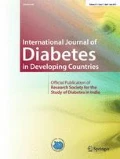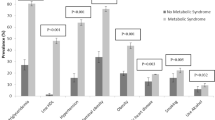Abstract
The present study was conducted to assess biochemical markers and Framingham risk score (FRS) (30-year risk of cardiovascular diseases) in patients with type 2 diabetes mellitus (T2DM) and compare with hypertensive and healthy controls. We also evaluated the influence of systolic blood pressure and duration of DM on biochemical markers and their correlation with the FRS in patients with T2DM. The study groups consisted of patients with T2DM (>5 years) with hypertension (n = 55), newly diagnosed T2DM <2 years without hypertension (n = 28), hypertensive controls (n = 31), and healthy controls (n = 30). After detailed medical history, all the participants were subjected to anthropometric measurements and biochemical estimations like blood sugar (fasting and post-prandial), glycosylated hemoglobin (HbA1c), creatinine, blood urea nitrogen, lipid profile, and microalbumin levels, and FRS was calculated. The blood sugar, HbA1c, cholesterol (total and low-dense lipoprotein), microalbumin, as well as FRS were elevated in patients with T2DM compared to healthy controls (p < 0.05). A significant correlation was observed between the FRS and blood sugar, HbA1c, and microalbumin in patients with long-term T2DM. Also, duration of DM significantly influenced levels of serum triglycerides, HbA1c, and microalbumin. This study reveals that elevated blood sugar, HbA1c, and microalbumin levels are associated with increased risk of cardiovascular diseases in patients with long-term diabetes mellitus.


Similar content being viewed by others
References
Brody H. Diabetes. Nature outlook 2012; 485(7398) Editorial. http://www.nature.com/nature/journal/v485/n7398_supp/pdf/485S1a.pdf. Accessed 2 Sep 2013
Ramachandran A, Das AK, Joshi SR, Yajnik CS, Shah S, Prasanna Kumar KM. Current status of diabetes in India: need for novel therapeutic agents. JAPI. 2010;58:7–9.
Nielson C, Lange T. Blood glucose and heart failure in nondiabetic patients. Diabetes Care. 2005;28:607–11.
Dokken BB. The pathophysiology of cardiovascular disease and diabetes: beyond blood pressure and lipids. Diabetes Spectr. 2008;21:160–5.
National Cholesterol Education Program (NCEP): Expert Panel on Detection, Evaluation and Treatment of High Blood Cholesterol in Adults (Adult Treatment Panel III) guidelines. National Heart, Lung, and Blood Institute; National Institutes of Health (NIH), September 2002. http://www.nhlbi.nih.gov/guidelines/cholesterol/atp3full.pdf. Accessed 23 Jun 2013
Anderson KM, Odell PM, Wilson PW, Kannel WB. Cardiovascular disease risk profiles. Am Heart J. 1991;121:293–8.
Americal Diabetes Association. Screening for type 2 diabetes. Diabetis Care. 2004;27 Suppl 1:S11–4.
Suryabhan LL, Chandrashekhar IM, Ratnendra RS, Prerna ND. A comparative study on the fasting and the postprandial dyslipidaemia in Type 2 diabetes mellitus. JCDR. 2013;7(4):627–30.
Maeda E, Yoshino G, Kasuga M. Diabetes mellitus as a risk factor for arteriosclerosis. Nippon Rinsho. 1993;51(8):2170–6.
Dinneen SF, Gerstein HC. The association of microalbuminuria and mortality in non-insulin-dependent diabetes mellitus. A systematic overview of the literature. Arch Intern Med. 1997;157:1413–8.
Coleman RL, Stevens RJ, Retnakaran R, Holman RR. Framingham, SCORE, and DECODE Risk Equations do not provide reliable cardiovascular risk estimates in type 2 diabetes. Diabetes Care. 2007;30(5):1292–3.
Lau KK, Wong YK, Chan YH, Yiu KH, Teo KC, Li LS, et al. Prognostic implications of surrogate markers of atherosclerosis in low to intermediate risk patients with type 2 diabetes. Cardiovasc Diabetol. 2012;11:101. doi:10.1186/1475-2840-11-101.
Pencina M, Agostino R, Larson M, Massaro J, Vasan R. Predicting the thirty-year risk of cardiovascular disease: the Framingham Heart Study. Circulation. 2009;119(24):3078–84.
Lehto S, Rönnemaa T, Haffner SM, Pyörälä K, Kallio V, Laakso M. Dyslipidemia and hyperglycemia predict coronary heart disease events in middle-aged patients with NIDDM. Diabetes. 1997;46(8):1354–9.
Brunzell JD, Davidson M, Furberg CD, Goldberg RB, Howard BV, Stein JH, et al. Lipoprotein management in patients with cardiometabolic risk. Diabetes Care. 2008;31(4):811–22.
Hayden MR, Tyagi SC. Isolated low high density lipoprotein-cholesterol (HDL-C): implications of global risk reduction. Case report and systematic scientific review. Cardiovasc Diabetol. 2005;4(1):1–14.
Stratton IM, Adler AI, Neil HAW, Matthews DR, Manley SE, Cull CA, et al. Association of glycaemia with macrovascular and microvascular complications of type 2 diabetes (UKPDS 35): prospective observational study. BMJ. 2000;321:405–12.
Klein R. Hyperglycemia and microvascular and macrovascular disease in diabetes. Diabetes Care. 1995;18:258–68.
Wei M, Gaskill SP, Haffner SM, Stern MP. Effects of diabetes and level of glycaemia on all-cause and cardiovascular mortality. Diabetes Care. 1998;21:1167–72.
Jeffcoate SL. Diabetes control and complications: the role of glycated haemoglobin, 25 years on. Diabet Med. 2004;21(7):657–65.
Khaw KT, Wareham N, Bingham S, Luben R, Welch A, Day N. Association of hemoglobin A1c with cardiovascular disease and mortality in adults: the European prospective investigation into cancer in Norfolk. Ann Intern Med. 2004;141:413–20.
Currie CJ, Peters JR, Tynan A, Evans M, Heine RJ, Bracco OL, et al. Survival as a function of HbA(1c) in people with type 2 diabetes: a retrospective cohort study. Lancet. 2010;375:481–9.
Basi S, Fesler P, Mimran A, Lewis JB. Microalbiminuria in type 2 diabetes and hypertension. Diabetes Care. 2008;31(supplement):s194–201.
Gerstein HC, Mann JF, Yi Q, Zinman B, Dinneen SF, Hoogwerf B, et al. Albuminuria and risk of cardiovascular events, death, and heart failure in diabetic and nondiabetic individuals. JAMA. 2001;286:421–6.
National Cholesterol Education Program (NCEP) Expert Panel on Detection, Evaluation, Treatment of High Blood Cholesterol in Adults (Adult Treatment Panel III). Third Report of the National Cholesterol Education Program (NCEP) Expert Panel on Detection, Evaluation, and Treatment of High Blood Cholesterol in Adults (Adult Treatment Panel III) final report. Circulation. 2002;106:3143–421.
Wilson PW, D’Agostino RB, Levy D, Belanger AM, Silbershatz H, Kannel WB. Prediction of coronary heart disease using risk factor categories. Circulation. 1998;97:1837–47.
Asselbergs FW, Hillege HL, van Gilst WH. Framingham score and microalbuminuria: combined future targets for primary prevention? Kidney Int Suppl. 2004;92:S111–4.
Mukhyaprana MP, Vidyasagar S, Shashikiran U. Clinical prolife of type 2 diabetes mellitus and body mass index—is there any correlation? Calicut Med J. 2004;2:e3.
Sinharoy K, Mandal L, Chakrabarti S, Paul UK, Bandyopadhyay R, Basu AK. A study on clinical and biochemical profile of low body weight type 2 diabetes mellitus. J Indian Med Assoc. 2008;106:747–50.
Acknowledgments
We owe the success of this work to the research participants who volunteered their time to participate in this study. Sincere thanks to the Director of Sir H.N Medical Research Society and Management, for organizing necessary funds to carry out this project. We are also grateful to Ethics Review Committee and Scientific Advisory Committee for approving this project
Author contributions
• Ms. Namrata B Kulkarni: Analysis of the data and drafting the manuscript
• Ms. Tejal K. Vedak: Biochemistry tests, anthropometric measurements, and data acquisition
• Dr. Meghana U. Ganu: Selection of patients, informed consent from participants
• Dr. Sanjay G. Godbole: Excellent clinical inputs during the conduct of the study
• Dr. Sudha S. Deo: Conception of the project and finalizing the manuscript
Author information
Authors and Affiliations
Corresponding author
Rights and permissions
About this article
Cite this article
Kulkarni, N.B., Vedak, T.K., Ganu, M.U. et al. Assessment of cardiometabolic risk factors and its association with Framingham risk score in Indian patients with type 2 diabetes mellitus. Int J Diabetes Dev Ctries 35, 340–345 (2015). https://doi.org/10.1007/s13410-015-0307-2
Received:
Accepted:
Published:
Issue Date:
DOI: https://doi.org/10.1007/s13410-015-0307-2




